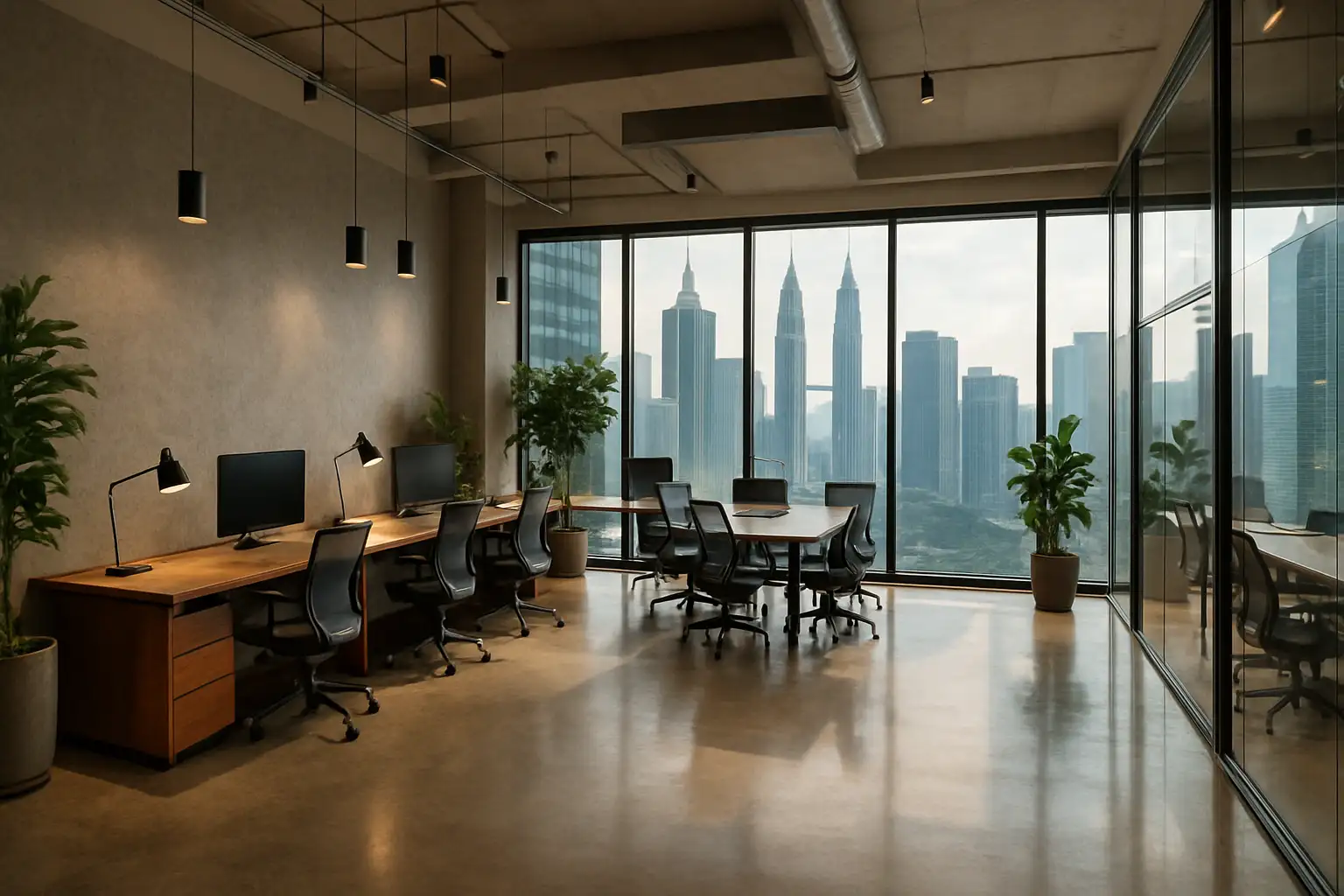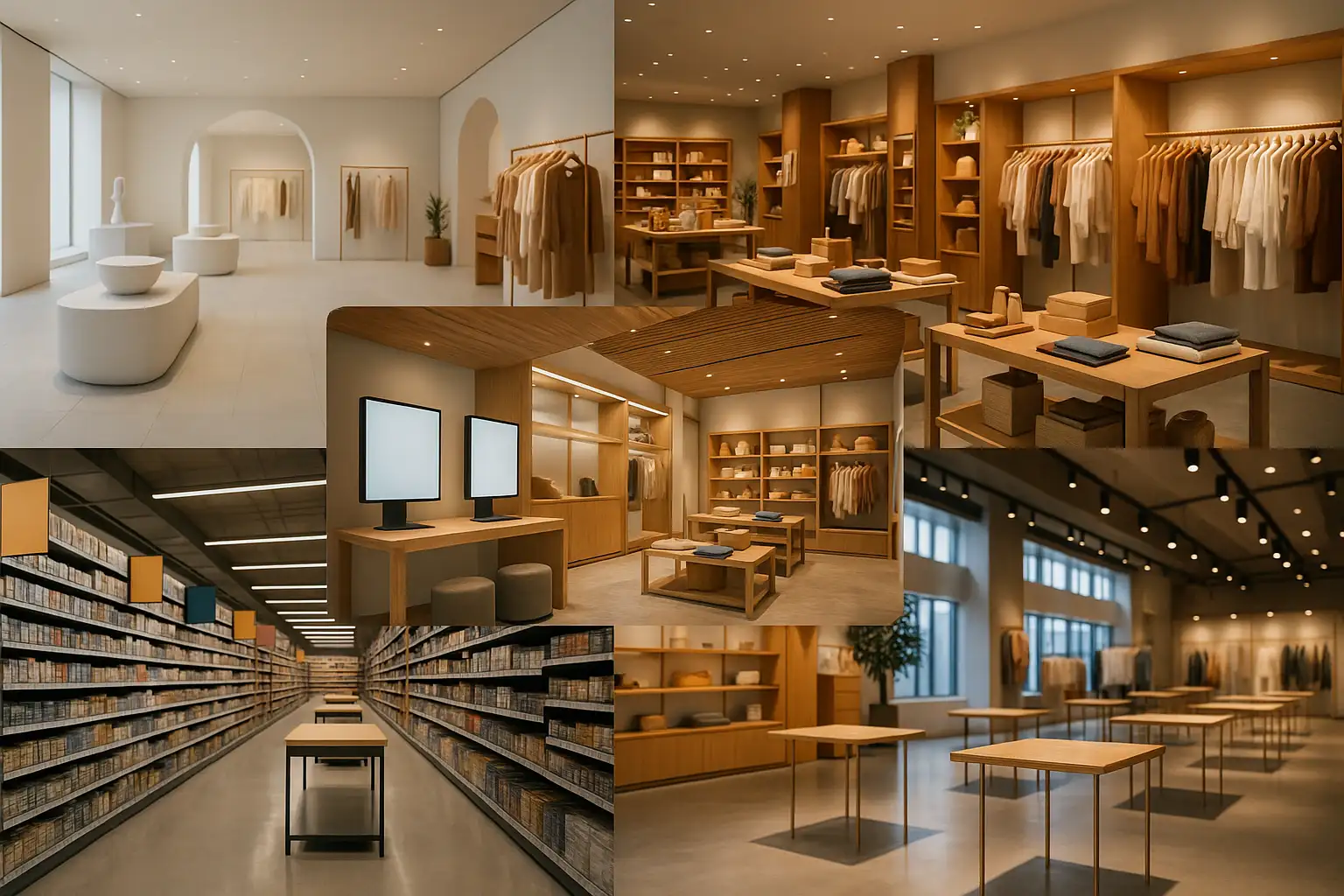5 Store Layouts That Lift Conversion
Match your store to one of five proven layouts to lift conversion: grid for predictable high-traffic flow, loop for guided exposure, free-flow for discovery in boutique settings, herringbone or spine for narrow spaces with strong sightlines, and boutique mixed for higher AOV. Pick based on traffic, product mix, and brand story, then apply the tactics below.
Layout Snapshot: Retail That Converts
- Grid: Parallel aisles drive reliable flow and endcap exposure.
- Loop: A guided path increases category exposure and impulse picks.
- Free-flow: Open vignettes raise dwell time and discovery.
- Herringbone or Spine: Angled sightlines and a central axis speed decisions in narrow stores.
- Boutique mixed: Curated pockets lift engagement and average order value (AOV).
Quick Comparison
| Layout | Best for | Watch-outs | KPI to watch |
|---|---|---|---|
| Grid | High SKU density, repeat trips | Monotony, aisle fatigue | Units per visit, aisle heatmaps |
| Loop (Racetrack) | Storytelling, full exposure | Slower quick trips, bottlenecks | % full-path traversal, endcap CTR |
| Free-flow | Boutiques, experiential small formats | Wayfinding confusion if over-open | Dwell time, add-on rate |
| Herringbone | Long and narrow footprints | Disorientation if angles are aggressive | Exposure per sq ft |
| Spine | Clear wayfinding across sections | Under-utilised side aisles | Time to key categories |
| Boutique mixed | Premium positioning and bundles | Fragmented visibility without anchors | AOV, bundle attach rate |
Grid Layout: Predictable Paths for High-Traffic Retail
A grid layout works when you need reliability at scale. Parallel aisles create a rhythm that most shoppers understand instantly, so navigation becomes almost automatic. This lets you place staples deeper in the store without annoying regulars, while endcaps and eye-level bays handle the heavy lifting for promotions and high-margin items.
If long runs start to feel monotonous, break them with a focal display at intersections, vary shelf heights in select stretches, and use a short decompression zone at the entrance so people settle before their first decision. Keep signage consistent from department to category to offer so the journey feels effortless rather than coached. For most high-SKU formats, the grid is your safest path to steady conversion and predictable replenishment.
Loop (Racetrack) Layout: Guided Circulation for Exposure
A loop layout engineers a purposeful journey. Customers follow a clear path that reveals categories in sequence, which is ideal for storytelling brands and multi-category concepts. Start broad at the entrance and narrow into specific themes as the route unfolds. Use lighting gradients to pull attention forward and place the most profitable or new categories just after natural slows in the path.
The risk is friction for mission shoppers who want one or two items, so build in visible shortcuts, mark an express route, and signal exits clearly. Watch for bottlenecks at tight turns and widen those points or trim fixture depth to keep the loop moving. Done well, a racetrack gives you comprehensive exposure without feeling like a forced march.
Free-Flow Layout: Discovery and Impulse Buys
Free-flow turns the store into a gallery, which is powerful for boutiques and experiential retail. Instead of rigid aisles, you curate islands and vignette tables that invite wandering. Anchor sightlines so there is always something obvious to move toward from the entrance, then layer smaller discoveries at natural pauses near fitting rooms or checkout. Clustering complementary items near those pauses is a simple way to lift add-on rate.
Rotate displays on a fixed calendar so novelty stays high but the space never feels random. Use subtle floor contrasts, vertical markers, and mirror placement to keep casual exploration from turning into confusion. The result should feel intentional, premium, and fresh, with discovery translating into higher dwell time and impulse purchases.
Herringbone & Spine Layouts: Clear Sightlines & Fast Navigation
Spine and herringbone are the workhorses for long, narrow footprints. A central spine sets a clean axis from entrance to focal zones. Off that spine, angled aisles in a herringbone pattern increase exposure on both sides and help short stores feel deeper and more dynamic.
Keep angles consistent and widths measured so the pattern reads as a design choice rather than a maze. Place endcaps at spine intersections to pull shoppers across categories, and put small, high-velocity items at the join points where angled runs meet the main corridor. If first-time visitors seem disoriented, reduce the angle slightly, simplify signage, and add a visible return path at the back wall to avoid dead ends. Used together, spine for clarity and herringbone for visibility can deliver fast navigation with strong exposure per square foot.
Boutique (Mixed) Layout: Curated Zones for Higher Average Order Value
A mixed layout borrows the navigational confidence of grids or spines, then inserts boutique pockets that feel like mini showrooms. Each pocket tells a tight story, which makes bundling and premium sets feel natural rather than upsold. Keep the global palette and lighting consistent so zones feel connected to the whole store, and position anchors so hero SKUs remain visible from core circulation.
Limit the number of micro-themes at any one time, refresh them on a calendar, and use clear price ladders to guide shoppers to upgrades without pressure. Mixed layouts shine when you want everyday efficiency and premium moments in the same footprint, which is often the most realistic way to lift average order value.
Implementation Playbook
- Give shoppers a small decompression area at the entrance, then place a strong focal point a few steps in to set pace and cue the first decision.
- As they move deeper, use endcaps with one clear offer, a large price card, and an obvious benefit. Add small "speed bump" displays before major category changes to slow traffic just enough for discovery without clogging aisles.
- Keep a simple signage hierarchy that repeats from zone to zone so people never have to think about how to read the store.
- Layer lighting: ambient for comfort, task for work areas, accent for hero bays, new arrivals, and bundles.
- Put cross-merchandising as close to the decision as possible: accessories near core items, complementary SKUs near mirrors or try-on points, and bundle prompts where a shopper naturally pauses.
30-Day Testing Plan
- Week 1: Record a baseline. Capture heatmaps, pathing, and the KPIs that matter most for your format: dwell time, units per visit, add-on rate, time to key categories, AOV. Identify dead zones and congestion points with photos and timestamps so you can repeat the test later.
- Week 2: Make a small number of high-impact changes. Move or add a few endcaps, adjust two or three speed bumps, and refresh your most visible vignettes. Align accent lighting with the updated focal points and keep notes on exactly what moved.
- Week 3: Review the data and decide what stays. Keep the winners, roll back the losers, and test one alternative layout for each underperformer. Resist the urge to change too much at once so you can read the results cleanly.
- Week 4: Lock the winning configuration and codify a monthly refresh schedule. Plan seasonal capsules, endcap rotations, and vignette swaps in advance so the store evolves without last-minute scrambles.
Store Layouts FAQ (Retail Conversion)
What are the main store layout types?
Grid, loop or racetrack, free-flow, herringbone, and spine. Many stores use a mixed approach that blends two or more to balance efficiency and experience.
Which layout increases conversion the most?
It depends on your format and goals. Grid is strong for high-SKU efficiency, loop improves full-path exposure and impulse, free-flow deepens brand engagement in smaller spaces, and mixed layouts often lift AOV through bundling.
What is a racetrack layout in retail?
A guided loop that routes shoppers past curated zones and endcaps while still allowing shortcuts for quick missions.
Is free-flow good for small shops?
Yes, if wayfinding is preserved. Keep visible anchors from the entrance, add subtle floor or vertical cues, and ensure a clear path to checkout so browsing feels intuitive.
How do I choose the right store layout?
Match traffic patterns, footprint, SKU density, brand story, and staffing model. Test changes with heatmaps and track dwell time, AOV, add-on rate, and time to key categories before you roll anything out chain-wide.
Final Word: Design the Journey
Choose the layout that fits your traffic and assortment, then refine sightlines, focal points, and endcaps until the data tells you the journey feels natural. Track dwell time, average order value, units per visit, and exposure to priority categories. Review monthly and keep iterating. Small, disciplined changes compound into higher conversion.
Want a second set of eyes on your floor plan? Book a 20-minute layout review. Book a Layout Audit




